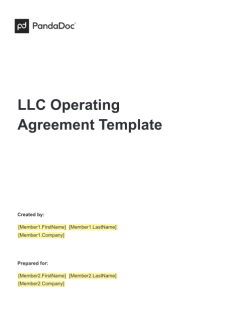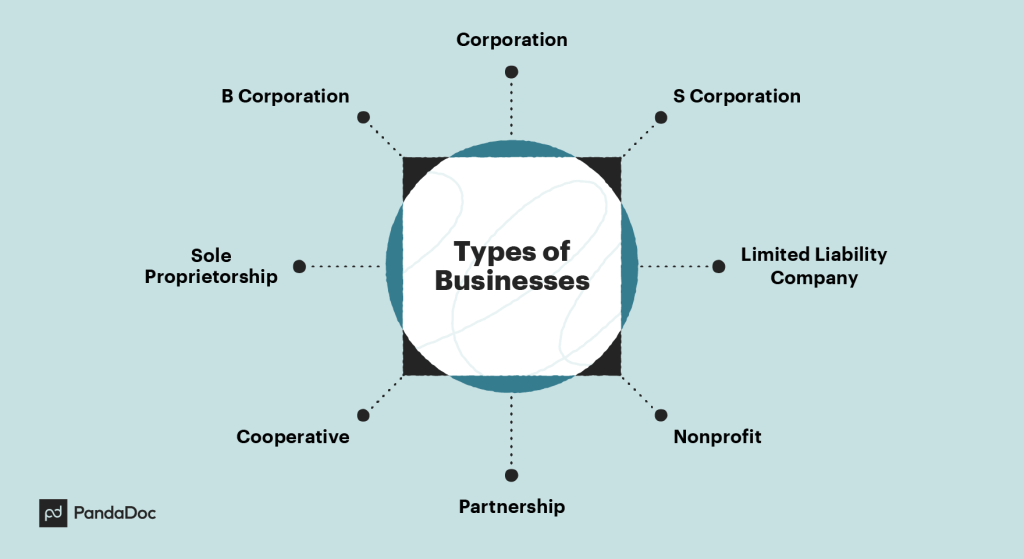More than 33.2 million small businesses are active in the United States today, with over a third of those being limited liability companies, also known as LLCs.
Although limited liability companies are the most popular corporate structure of small business owners, many individuals still don’t completely understand what an LLC is or how to operate one.
Luckily, PandaDoc’s work with hundreds of clients (many of them LLCs) has helped us gain insight into what constitutes an LLC and how you should go about creating your own.
Without further adieu, let’s get to the bottom of what a limited liability company means in business and why you may want to form one.
What is an LLC?
An LLC, also known as a limited liability company, is a corporate structure that is formed to own and operate a business.
Limited liability companies are the most popular business structure because they are relatively simple to operate while offering business owners limited liability protections.
These protections allow a business owner’s personal assets, such as their personal savings, real estate, and more, to be unaffected if the LLC incurs a legal liability such as debt.
There is no limit on how many business members can operate under an LLC. What’s more, limited liability company members can include individuals, other LLCs, corporations, and even foreign entities.
Plus, LLCs avoid corporate tax, which can create a double taxation scenario. We’ll explain this more throughout this blog post.
For now, let’s compare what an LLC is to other types of corporate structures.

LLC Operating Agreement Template
Used 4872 times
Streamline operations to ensure you’re running your business smoothly with a free LLC Operating Agreement Template.
Use this templateWhat’s the difference between an LLC and other corporate structures?
An LLC is just one type of structure for an official business. Other business structures include sole proprietorships, partnerships, several classes of corporations, nonprofits, and collectives.
PandaDoc has worked with hundreds of businesses to help them achieve their goals based on the type of structure they employ.
Let’s walk through each of these business structures and how they differ from a limited liability company.
1. Sole proprietorship
A sole proprietorship is a type of structure that occurs when a business owner does not officially register as a specific business structure with their state.
When one’s business is under a sole proprietorship, assets and liabilities for the business and the individual are blended, creating liability issues.
Alternatively, an LLC will protect your personal assets from any business-related losses. While a sole proprietorship may work for those in the early stages of launching their business, it’s best to file for an LLC or other structure once your business begins taking on serious liabilities.
Otherwise, your personal assets may be in jeopardy.
2. Partnership
Partnerships can be ideal for two or more people who want to create a business together. This corporate structure is relatively simple and is usually structured as either a limited partnership or a limited liability partnership.
With limited partnerships, only one partner’s assets are protected from business-related debts. However, this person also holds more power.
Just like sole proprietorships, one member of a limited partnership may be held personally liable for business losses. This makes an LLC a safer route for those with many personal assets that need protection.
With limited liability partnerships, every owner is protected from debts against the partnership, and no partner is responsible for acts of another.
This is a good option for two individuals trying to test the waters of their business before filing for a more complicated business structure.
3. Corporation
This is an entity that is entirely separate from its owners. The corporation and/or enterprises can be held legally liable, be taxed, and make profits like individuals.
Corporations are more expensive to create and require more administrative burdens such as record keeping and reporting. These types of entities are ideal for high-risk companies, would like to go public, or be sold in the future.
One benefit of the structure for corporations is that it allows companies to raise capital by selling stock, which is a power limited liability companies do not have.
So, while LLCs are more simple in terms of record-keeping and reporting, they do not have as many fundraising or future sale capabilities as corporations do.

4. S corporation
While still a corporation, an S corporation permits some profits and losses to be added to the owner’s personal income without being subject to corporate tax rates.
These corporate tax rates will vary by state. S corps require filing with the IRS under special criteria and are limited to 100 maximum shareholders.
S corps must provide the Secretary of State with ongoing filings and fees and need to uphold strict rules about meetings and record keeping.
Plus, S corps usually needs a board of directors, while an LLC’s direct members can manage business activities.
5. B corporation
B corporations, on the other hand, are more mission-based corporations. They are focused on a public benefit and take more stakeholders than just shareholders into account.
They are usually concerned with the community, environment, and employees. While an LLC may have a specific business-focused mission, a B corporation will have a mission that includes internal and external stakeholders to achieve a public benefit.
As with most corporations, B corporations require a higher administrative burden than LLCs.
6. Nonprofit
Nonprofits are created for charitable purposes. The main benefit of a nonprofit is that they are exempt from state, federal, and income taxes if they file correctly as a 501(c)(3) with the IRS. Nonprofits are restricted from distributing profits to their owners or members.
There is also a high administrative burden on these entities, as they must set up separate bank accounts and keep proper records to maintain their 501(c)(3) status.
Nonprofits have rules about how the business can apply profits, while limited liability companies do not. You’ll want to initiate an LLC if you want to personally earn a profit from your business, as nonprofits do not have this power.
7. Cooperative
This type of structure is owned by those who use its services. Cooperatives are typically managed by a board of directors, while members may have some voting power. Profits from the cooperative are distributed among all the members, who are known as user-owners.
Power is more distributed in a cooperative than in an LLC. A limited liability company would be a wiser choice if you’re looking to spearhead business activities without considering the interests of every single stakeholder who uses the business’ services.
These brief descriptions should give you a basic understanding of the different types of business structures and their uses.
If you have any specific questions about what kind of business structure is best for your venture, contact PandaDoc today to learn how we can help.
Despite all this information on the different ways to structure a business, an important question remains: What about taxation?
How are limited liability companies taxed?
LLCs are taxed by what is known as pass-through taxation. This type of taxation occurs when an LLC’s profits pass through its members and is reported on members’ personal tax returns.
All of the LLC profits are taxed one time at the members’ individual income tax rate.
Because they’re taxed this way, LLCs do not incur double taxation where profits from the business are taxed at the corporate level and then once again at the personal level.
LLCs also allow individuals to make tax deductions for business expenses, which can offset the costs of launching and maintaining your business.
So, what are some of the benefits of forming an LLC?
Pros and cons of forming a limited liability company
As with every business structure, there are pros and cons to creating an LLC for your business. Here are a few perks and drawbacks PandaDoc has collected to help steer you and your future business in the right direction.
Benefits of an LLC
The most major perk of an LLC is initiating limited liability to protect your personal assets. Unfortunately, not all businesses are successful.
Failure to create limited liability for your business may result in the loss of personal assets, including personal savings, real estate, and other assets, such as vehicles.
To keep your personal assets safe in the instance your business incurs an unintended or unexpected loss (see COVID-19), form your business as a limited liability company.
Another benefit of forming your business as a limited liability company is pass-through taxation. Now, you may wonder, why is pass-through taxation considered a benefit?
Corporations, unlike LLCs, are burdened by double taxation, which occurs when income tax is paid once at the corporate level then again at the personal level.
Essentially, the income is taxed twice rather than once, as seen in the pass-through taxation of LLCs.
This benefit is shared by limited liability companies, sole proprietorships, and S corporations. However, the latter two business structures do not have the limited liability protection as described above.
Next, filing and managing an LLC is relatively flexible as compared to corporations. Corporations require articles of organization, bylaws, a board of directors, and regular meeting intervals.
In contrast, LLCs can be managed by a variety of members and types of members. Plus, LLCs only need an operating agreement to file with the Secretary of State.
Finally, forming your business as an LLC gives it greater credibility. It shows you’ve gone the extra mile to officially file your business with the Secretary of State, which gives your future customers and associates a greater sense of trust in your business.
Creating an LLC shows you’ve done your due diligence in getting the business properly launched and have given thought to what kind of business you want to operate as.
Although, an LLC isn’t the perfect structure for every business. Here are a few cons of LLCs you should also keep in mind.
Drawbacks of an LLC
First and foremost, any failure to separate your personal and business transactions in your LLC may eliminate the company’s limited liability.
Therefore, your personal assets could no longer be protected if you do not keep your personal and business actions distinctly separate. For these reasons, it is always recommended to keep personal and business transactions completely separate and validate this with rigorous record-keeping.
In addition, there is greater administrative work required of an LLC than a sole proprietorship, for instance. Your registered agent will need to file the initial paperwork to officially file the limited liability company with the Secretary of State.
They’ll also need to file new paperwork with the state if your membership changes. There are costs associated with filings, too, such as the cost to initially file the LLC with the Secretary of State as well as potential annual reports.
Finally, an LLC business structure is less attractive to angel and private investors than a corporation. This is because limited liability companies require operating agreements, which can be complex for investors to navigate.
Plus, LLCs cannot have shareholders. Furthermore, investors may be less inclined to invest in an LLC because of the pass-through taxation, creating additional taxable income.
So, how do you decide if an LLC is a right way to structure your business?
How to know if an LLC is right for you
Through our expert insight on business structures, PandaDoc has a few pointers to help you determine if an LLC is right for you.
First, you may want to form your business as a limited liability company if you’re starting your first business and want to test your proof of concept.
Given the simplicity of an LLC, you should be able to file it with the Secretary of State without dedicating too much time, energy, and money. What’s more, you may want an LLC if you have a considerable amount of personal assets that business losses could jeopardize.
A limited liability company may not be the right choice for your business if you need to attract investors to get your business off the ground or you foresee frequent membership changes that could create an administrative burden.
If you want investors, consider creating a corporation. If you want to hold controlled power in your business without filing changes to members and executives, consider choosing a sole proprietorship.
How to set up your own LLC
Now that you know all about LLCs and their advantages, it’s time to set up your own. Here are the steps you need to take to launch your very own LLC.
1. Choose a business name
First things first, your LLC needs a name to be filed. Before choosing your name, conduct a business name search on your state’s Secretary of State website to ensure your preferred name isn’t already taken.
You’ll also have to follow your state of operation’s LLC naming guidelines, which usually include listing “LLC” in your name and avoiding using names that could confuse your business with a government agency.
If you’re having trouble deciding on a name, don’t overthink it. Your LLC name and your public-facing name can be different. Most businesses will provide a dba, known as a “does business as” name, that is more catchy for marketing purposes.
2. Designate an agent
Next, you need to choose a registered agent to receive legal paperwork and official correspondence on behalf of your business. The agent can be a person or a business, but they must either be a resident or authorized to do business in your state of business.
3. Obtain a copy of your state’s LLC forms and fill them out
After you’ve designated an agent, you’ll need to acquire a copy of limited liability company formation documents from your Secretary of State and fill them out accordingly.
5. Create an LLC operating agreement
The next step in creating your LLC is drafting the operating agreement. An operating agreement, which is required in most states, describes how the limited liability company will be operated.
This will help keep your personal and business actions separate to receive the limited liability perks of an LLC.
For those who have multiple members managing an LLC, be specific as to the role of each member and how the profits will be distributed among them. Other items to include in your operating agreement are how new members will be added, if at all, and how losses will be split.
Drafting an operating agreement template doesn’t have to be stressful.
PandaDoc has studied numerous operating agreements and created this flexible, easy-to-use operating agreement template that can simplify this process without hiring a lawyer.
6. File the forms with the state
Once the forms are complete and you’ve created an operating agreement, file these documents with the Secretary of State. There is usually a nominal fee associated with the filing at $100 or less.
The state will then send your agent documentation that your LLC is active.
There you have it. Creating your very own LLC isn’t as intimidating as it may seem.
After reviewing what an LLC is, comparing it to other types of business structures, evaluating the pros and cons, and learning how to file a limited liability company from start to finish, PandaDoc can help answer any questions you may have about this process.
Contact us today so we can help you launch your new business the right way.


